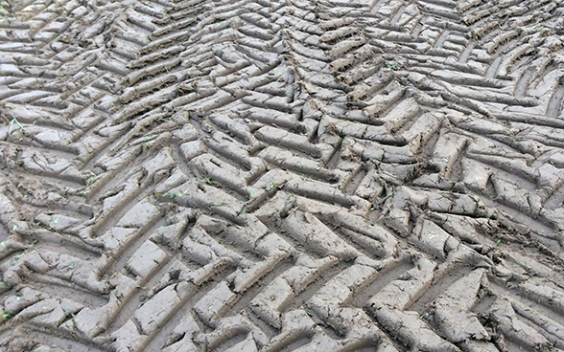Soil pressures can be divided up into physical (mechanical), chemical (material) and biological pressures.

There are countless causal relationships between the pressure types. For example, soil compaction induces surface water runoff and thus soil erosion. Yet, pollutants can harm the organisms that form and loosen soil, thereby enabling erosion and compaction.
Physical soil pressures
Soil compaction and erosion are the two main physical pressures on soil.
Soil is compacted when its pores, or open spaces, are pressed together. This occurs when soil is handled or driven over by heavy machines or vehicles. Soil moisture plays a crucial role in soil compaction. In compacted soil, water can no longer seep away, air is prevented from circulating, and decomposition processes and root growth are inhibited. Soil used for agriculture or intensive hay farming in Switzerland is at the highest risk of compaction.
When soil erodes, fertile fine soil is washed away by water. The main cause of erosion in Switzerland are farming methods that are unsuited to the location. Soil on steep slopes and fields without a stable grass cover are particularly in danger of erosion. The same goes for soils that are used for the intensive production of vegetables. The agricultural sector can incur huge economic losses as a result of soil erosion. Yet, soil erosion is not only a soil protection problem. Nutrient and pollutant-containing soil material that has washed away can contaminate bodies of water or valuable biotopes. In addition, erosion events damage sewer systems and transport infrastructures by fouling them or covering and blocking them with mud and rocks.
Chemical soil pressures
Significant quantities of pollutants land on the soil surface and enter the soil through polluted air, rain and dust deposition, mineral fertilisers and farmyard manure, the recycling or illegal disposal of waste, plant protection products, etc. Knowledge of the impacts of these contaminates is often non-existent or rudimentary. Some of these substances accumulate in the soil, while others enter the water or air from the soil and the food chain through plants. Once in the soil, they may damage the soil biota and thus soil fertility. By polluting the soil, humans indirectly contaminate drinking water and ultimately themselves. They also put themselves at risk through direct contact with the soil.
Problematic soil pressures are generally associated with highly specific or narrow monoculture practices (e.g. viticulture), proximity to major pollution sources (street traffic, metal-working installations) and unregulated use of contaminated excavated soil, or arise as a result of past uses (contaminated sites). High pollution levels can, however, also have natural causes (composition of the parent rock).
Biological soil pressures
Biological soil pressures are impacts caused by genetically modified, pathogenic or invasive alien organisms. Although soil is not seriously threatened by these pressures at this time, they remain very real threats. Due to globalisation, goods are moved around the world increasingly rapidly. Sometimes organisms that can impair the fertility of our soil are transported as stowaways along with these goods. Organisms that disrupt the ecosystem can also enter the soil through controlled release experiments.
Land use
Soil that has been removed by mechanical diggers or sealed over can no longer fulfil its natural functions in the ecosystem. Eleven hectares of agricultural land continue to disappear every day. In view of the constantly growing population it is to be expected that pressure to build up soils will remain high, specially in and near existing settlement areas. A key issue for soil protection is therefore to ensure more economical and judicious management of soil as a resource. Spatial planning tools are also necessary for that purpose.
Last modification 24.08.2021





